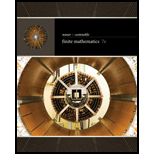
Study Techniques Your mathematics test is tomorrow and will cover the following topics: game theory, linear programming, and matrix algebra. You have decided to do an all-nighter and must determine how to allocate your 8 hours of study time among the three topics. If you were to spend the entire 8 hours on any one of these topics (thus using a pure strategy), you feel confident that you would earn a 90% score on that portion of the test but would not do so well on the other topics. You have come up with the following table, where the entries are your expected scores. (The fact that linear programming and matrix algebra are used in game theory is reflected in these numbers.)
Test
| Your Strategies | Game | Linear Programming | Matrix Algebra |
| Game Theory | 90 | 70 | 70 |
| Linear Programming | 40 | 90 | 40 |
| Matrix Algebra | 60 | 40 | 90 |
You have been told that the test will be weighted as follows: game theory: 25%, linear programming: 50%, and matrix algebra: 25%.
a. If you spend 25% of the night on game theory, 50% on linear programming, and 25% on matrix algebra, what score do you expect to get on the test?
b. Is it possible to improve on this by altering your study schedule? If so, what is the highest score you can expect on the test?
c. If your study schedule is according to part (a) and your teacher decides to forget her promises about how the test will be weighted and instead bases it all on a single topic, which topic would be worst for you, and what score could you expect on the test?
Trending nowThis is a popular solution!

Chapter 4 Solutions
Finite Mathematics, Loose-leaf Version
- MATLAB. Awnser written questions (*) in the comments. Null, Rank, and most functions outside of rref() and disp() are not allowed! Solutions must be given manually! Elementary form means to reduce to RREF manually, without rref(). Please see other attached image for explanationarrow_forwardIn ΔEFG, e = 520 inches, ∠E=26° and ∠F=107°. Find the area of ΔEFG, to the nearest 10th of an square inch.arrow_forwardIn ΔXYZ, ∠Y=90° and ∠X=25°. ∠ZWY=73° and XW=7.2. Find the length of WY to the nearest 100th. Figure not necessarily drawn to scale. XYWZ25°73°7.2?arrow_forward
- In ΔABC, a = 380 inches, ∠A=72° and ∠B=9°. Find the area of ΔABC, to the nearest 10th of an square inch.arrow_forwardPlease refer belowarrow_forwardFor the following function f and real number a, a. find the slope of the tangent line mtan = f' (a), and b. find the equation of the tangent line to f at x = a. f(x)= 2 = a = 2 x2 a. Slope: b. Equation of tangent line: yarrow_forward
- Please refer belowarrow_forwardMATLAB. Awnser written questions (*) in the comments. Null, Rank, and most functions outside of rref() and disp() are not allowed!arrow_forwardMATLAB. Awnser written questions (*) in the comments. Null, Rank, and most functions outside of rref() and disp() are not allowed! Solutions must be given manually! Elementary form means to reduce to RREF manually, without rref(). Please see other attached image for explanationarrow_forward
 Elementary Geometry for College StudentsGeometryISBN:9781285195698Author:Daniel C. Alexander, Geralyn M. KoeberleinPublisher:Cengage Learning
Elementary Geometry for College StudentsGeometryISBN:9781285195698Author:Daniel C. Alexander, Geralyn M. KoeberleinPublisher:Cengage Learning
